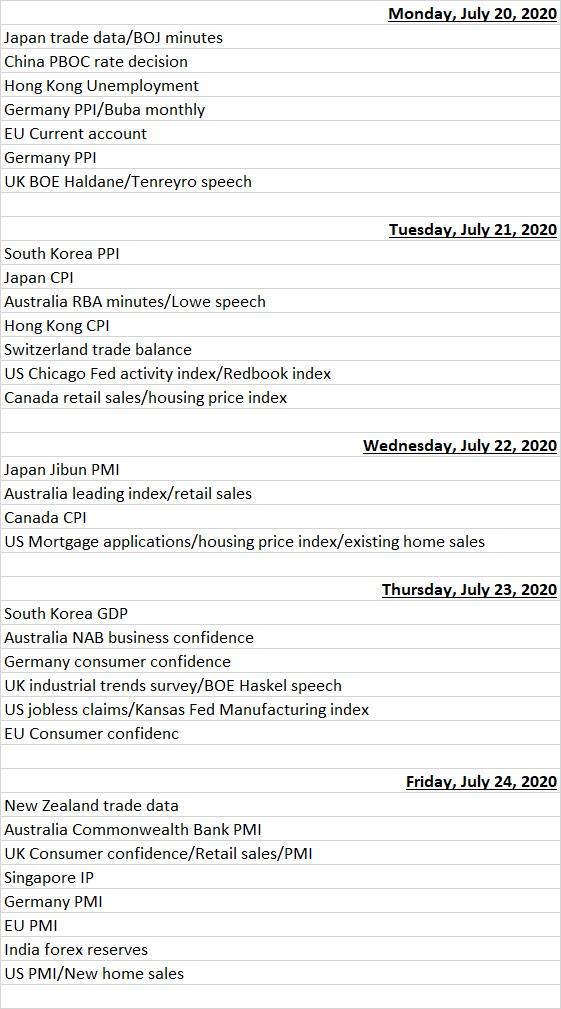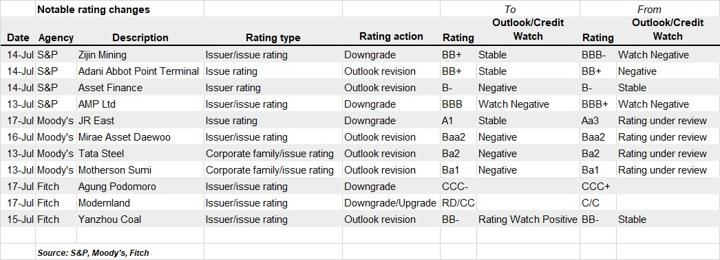(ATF) Economic events
In the week ahead flash PMI updates for the US, Europe and Japan will be assessed for further recovery signs at the start of the third quarter. Also keenly watched will be South Korea GDP updates, trade figures in Taiwan and Thailand, alongside employment data for Singapore, Hong Kong SAR, and Taiwan.
Markets will be keen to know if South Korea is able to dodge the technical recession bullet like China did earlier this month.
“Exports, imports, manufacturing and services output – everything was falling in the last quarter, while the second wave of Covid-19 outbreak kept confidence close to a record low,” ING Bank economist Prakash Sakpal said in a note. He expects South Korea to report a 2.5% quarter-on-quarter GDP contraction.
After South Korea’s GDP shrank 1.3% in 1Q, such a contraction would confirm a technical recession, marking the first recession since the SARS pandemic in 2003, Sakpal said.
“It’s likely to be worse. Hopefully, it will also mark the bottom of the current downturn,” he added.
Markets will also be waiting for the decision by China’s central bank on its benchmark lending rate for July – the Loan Prime Rate (LPR). It is widely expected to stay unchanged after the People’s Bank of China (PBoC) maintained its medium term lending facility (MLF) on 15 July. The one-year LPR is currently at 3.85%, while the five-year rate stands at 4.65%.
“Policy stance could remain hawkish and we no longer expect the PBoC to lower LPR before end-2021, despite future uncertainty,” BofA Securities analysts said in a note.
This hawkish stance has steepened the yield curve in China with the 10-year Chinese government bond yield now up 57 bps from the low of 2.48% reached in April.
Jefferies analyst Christopher Wood has taken this as a sign of improved cyclical momentum increasing China’s weighting in his model global sovereign bond portfolio by ten percentage points. He said this will increase the average yield to maturity on the portfolio from 3.63% to 3.84% with 60% of the portfolio now invested in Chinese 10-year bonds.
Fund flows
Investors pulled cash out of money markets and put it to work with China, ESG and SRI-themed funds continuing to attract flows.
“The unwinding of US MMFs resumed at a record pace!,” said Kenneth Chan and Tommy Tang of Jefferies’ Global Strategy team. They said a total of US$191 billion has now been liquidated from US MMFs since mid-May – around 16% of the $1.2 trillion injected since March.
In the week ended July 15 there were $77 billion of outflows from EPFR-tracked Money Market Funds with Alternative Funds absorbing a net $725 million, Equity Funds $4.7 billion and Bond Funds $9.3 billion.
“The desire among investors to put money back to work, however, remains tempered by rising Covid-19 caseloads in the Americas, the lack of certainty about the economic damage done by the pandemic over the past four months and its likely course over the next six months,” said Cameron Brandt, director of research at funds data provider EPFR Global.
EPFR said 80% of the equity inflows went to funds with socially responsible (SRI) or environmental, social and governance (ESG) mandates.
“Sentiment towards China continued to rebound in mid-July, with China Equity Funds posting consecutive weekly inflows for the first time since late March and China Bond Funds posting a new weekly inflow record,” it said.
Bond funds witnessed inflows as well with investors seeking yields.
“While inflows into high-grade and high-yield have continued for another week, government bond funds have recorded a sizable outflow. With negative yielding assets surging again amid a lack of yield in government bond land, investors have been favouring corporate credit to reach for positive yield,” BofA Securities analysts said in a note.
Economic data calendar

LAST WEEK’S RATING CHANGES

























